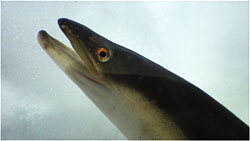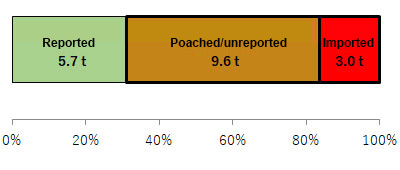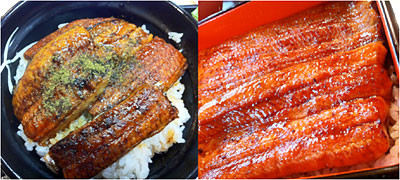Top>Opinion>Thoughts on eel conservation during Japan’s biggest eel-eating day of the year
 Index
Index
Thoughts on eel conservation during Japan’s biggest eel-eating day of the year
Kenzo Kaifu
Associate Professor, Faculty of Law, Chuo University
Director, Eel Conservation Research Unit, Chuo University Research Development Initiative
Member, International Union for Conservation of Nature Species Survival Commission (IUCN SSC) Anguillid Eel Specialist Group (AESG)
Area of Specialization: Conservation Ecology
There is an old saying in Japan that if you eat an eel on the Day of the Ox in midsummer, you’ll have the stamina and energy to survive the hottest days of the year. The Day of the Ox falls on July 25 and August 6 this year, and like every year, I imagine that there will be a flood of eel-related reports that come out as the day gets closer, as well as countless people who actually go out and eat an eel. In the meantime, Japan’s eel situation is—to put it bluntly—completely broken. It’s so far outside people’s normal assumptions, and the general public appears to be totally in the dark about it. Since this is the time of year when we eat more eels than any other, I want to take this opportunity to give you the facts on our consumption of Japanese eels that make their habitat in Japanese waters.
The declining Japanese eel population

Figure 1. The Japanese eel is facing the threat of extinction
The Japan Ministry of the Environment designated the Japanese eel (Anguilla japonica) as an endangered species in 2013, and the International Union for Conservation of Nature (IUCN) followed suit with the same designation the year after. The reason for the endangered classification by the MOE and the IUCN was that the species’ numbers are expected to fall by at least half within three generations. Some of the key factors thought to be contributing to its decline are overconsumption, environmental deterioration in the rivers and coastal areas where the eels grow, and changes in the ocean environments where they spawn. As we’re coming upon the Midsummer Day of the Ox, in this article I’m going to discuss only the timeliest of these threats—overconsumption.
Failing to properly manage natural resources
| Maximum inflow volume | Actual inflow during the 2015 fishing season | Actual inflow during the 2016 fishing season | |
| Japan | 21.7 | 18.3 | 19.7 |
|---|---|---|---|
| China | 36.0 | 9.3 | 8.2 |
| Korea | 11.1 | 7.4 | 9.3 |
| Taiwan | 10.0 | 2.8 | 3.2 |
| Total | 78.8 | 37.8 | 40.4 |
Table 1. Maximum inflow of glass eels vs. actual inflow in Japan, China, Korea, and Taiwan
Sustainably using resources that are in decline requires proper management. Currently, Japanese eel resources are being managed in Japan, China, Taiwan, and Korea by setting restrictions on volume of juvenile eels (known as glass eels) for aquaculture use. What this means is that eel farmers can only bring a certain amount of glass eels into the ponds in which they are raised to be a certain size to be edible. The regulation itself is called the “culture pond inflow restriction.” Starting in 2015, the main areas that consume Japanese eels—Japan, China, Taiwan, and Korea—set an upper limit on their collective glass eel usage, and then assigned quota to each party. The introduction of shared culture pond inflow restrictions for Japanese eels is a major step towards proper resource management for the species.
That said, there is still a major problem with the current culture pond inflow restrictions. The collective upper limit set for all four parties was 78.8 tons, but the actual volume of glass eels brought in during the 2015 fishing season (which runs from late 2014 through mid-2015) was 37.8 tons. The figure for the 2016 fishing season was 40.4 tons—just 48.0 and 51.3 percent of the 78.8-ton limit, respectively. The limit is clearly excessive given the actual amount of glass eels being brought into these fisheries, and will likely have almost no effect when it comes to reducing consumption volume. In other words, our Japanese eel resources are still not being properly managed, despite the fact that declining populations have been recognized as a problem.
Rampant poaching and smuggling

Figure 2. The reported inflow of glass eels used by domestic eel farms during the 2015 season was 18.3 tons. Subtracting the 3.0 tons of imported glass eels gives us a domestic catch of 15.3 tons. Of that, 5.7 tons were properly reported, leaving 9.6 tons of domestic glass eel caught through illegal means—whether poaching or underreporting. The 3.0 tons of glass eels were imported from Hong Kong, which doesn’t have a glass eel fishing industry. It is therefore suspected to have been smuggled in from a different country of origin.
One of the most severe issue threatening Japanese eels is the illegal catching and distribution of glass eels. Fishing for glass eels requires a permit, and those with a permit are required to report their catch. During the 2015 fishing season, however, the reported catch was no more than 37 percent of the total volume of glass eels caught in Japan’s domestic waters (figure 2). The remaining 63 percent (equivalent to 9.6 tons of glass eels) was traded through illegal means—either because it was caught by those fishing without a license or because it was over and above what licensed eel fishers actually reported (unreported catch). There were another 3.0 tons of imported glass eels, which, according to trade statistics by Japan’s Ministry of Finance, were found to have all been exported from Hong Kong—and the glass eels that Japan imports from Hong Kong are believed to have been smuggled into the region from Taiwan and other areas subject to export restrictions[1].
Glass eels that end up in culture ponds as a result of these unlawful fishing and trade practices are mixed in with specimens obtained through legal means, making it impossible to separate the two. This means that Japanese consumers are encountering the same high percentage of illegally fished or traded eels whether they buy frozen kabayaki at the supermarket or order an unaju rice bowl at a high-end broiled eel restaurant, as long as the eel is cultured in Japan.
Eel and compliance issues
When Anguilla japonica is sold within Japan, it is often labeled as a “domestic eel” for promotional purposes. But when a company carries a “domestic eel,” it means that they are carrying a product whose legality is highly suspicious. We have to call into question the compliance of everyone involved in the supply chain—not just the organizations directly involved in catching the glass eels, but also the eel farmers, distributors, eel restaurants, and so on. Did every single one of the companies and organizations follow the law to the letter?
Unfortunately, it is nearly impossible to get a domestically raised eel of proven legality at this time. So we’re not at a point where we can tell people that they need to immediately avoid trading in suspicious domestic eels. But if an organization or a company doesn’t work to change the current situation and get things back to normal, it is going to have some serious compliance issues.
The issue of compliance is not limited to private companies and organizations, either. There have been examples of government involvement in domestic eel trades as well, including in the form of “gifts” given in return for tax-deductible donations to municipal governments under Japan’s furusato nozei (hometown tax) payment scheme. Educational institutions have also been known to supply eels, whether through school lunches or at university co-op cafeterias. It’s government agencies and educational institutions who should be paying the most attention to compliance issues, and they should therefore avoid getting involved with domestically raised Japanese eels except in cases where its legality can be fully confirmed.
Is it bad to eat a cheap eel?

Figure 3. Unadon served at a fast-food chain (left) vs. unadon served at a specialty restaurant (right)
With reports of declining Japanese eel populations, you often hear people saying things to the effect of “there are fewer eels because of mass consumption, so you should eat it less frequently, and when you do eat it, you should get an eel that is carefully prepared by a specialty shop rather than an eel sold in supermarkets, convenience stores, or as fast food.” Given the current eel situation, it’s not hard to understand how people might arrive at these conclusions. But if we define our goal as “the sustainable use of Japanese eels,” then we need to reconsider what the impact of having consumers eat eels less frequently or choosing specialty shops really is.
If we want to use Japanese eels sustainably, we do need to reduce our current consumption levels. And if individual consumers start eating eels less frequently, consumption may go down. But shouldn’t reductions in eel consumption be achieved through advances in fishery management and other systemic social reforms? Societies that set appropriate limits on consumption and stay within those limits will achieve sustainability. Societies that leave what is effectively an all-you-can-catch, all-you-can-eat system in place and attempt to reduce consumption through individual consumer behavior cannot be considered sustainable. And when it comes to eating an eel from a specialty shop, supermarket, convenience store, or fast-food chain, as long as we stay within properly-set consumption limits, it’s not society’s place to limit whether a seller offers a cheap eel rice bowl for ¥500 or premium grilled unaju meal for ¥5,000. That’s up to each company and the way they want to do business. And individual consumer behavior—something that is heavily impacted by personal values and economic conditions—should be allowed the most freedom of all. We’ve got to be careful that our efforts to “not eat eels indiscriminately” don’t turn into criticism of those who purchase cheap products. Assuming that our underlying goal is to use eels sustainably, we’ve got to separate our choice of certain preparations from the need for systemic social reforms if we’re going to define the problem clearly.
The public’s role in solving our eel problems
Reforms of social system typically involve a legislative development of laws that are then put into practice by government agencies[2]. But because there are so many social issues yet to be resolved, these government bodies have no choice but to prioritize the problems that are most urgent. The fact that we’ve made so little progress towards setting strict consumption limits rooted in scientific fact or properly reforming our social systems to address declining eel populations means that our legislature and government agencies do not yet see the issue as a serious problem—or as serious enough to warrant action.
So what role can consumers play in the current situation? We need to make the sustainable use of eels a matter of social concern. If more people speak out about wanting to use our eel resources sustainably, not wanting to eat eels that have been traded through illegal means, or wanting to improve the river and coastal environments where these animals live, we can influence our legislature and government agencies to make the eel problem a higher priority. Doing so requires that we become better informed about Japanese eels, think about the issue from our own perspectives, and share them with as many people as possible. The Midsummer Day of the Ox just might be the perfect opportunity to think a little more deeply about the eel problem we’re facing and make it a topic of conversation.
- ^1. Suspicions about eel smuggling via the Hong Kong route were reported in an article entitled “Forget eating an eel on the Day of the Ox! The truth about eel smuggling revealed” [Doyo no ushi no hi wa iranai, unagi mitsuyu no jittai wo abaku] in the August 2016 edition of Wedge, as well as in an episode of Close-up Gendai Plus titled “‘White diamonds’: Following eel smuggling routes” [“Shiroi daiya” unagi mitsuyu ruto wo oe!], which aired on NHK on December 1, 2016.
- ^2. There are also legally-independent voluntary systems in place, known as resource management certification programs. Consumers can elect to purchase marine products certified under standards such as those set forth by the Marine Stewardship Council (MSC) or the Aquaculture Stewardship Council (ASC), for example, which allows them to push for more sustainable practices in the fishing industry. Unfortunately, there is not a certification program to ensure that eel products are both sustainable and legal.
If you’re interested in learning more about the issue including challenges facing eel habitats, visit our Ungai Report website (Japanese only).
- Kenzo Kaifu
Associate Professor, Faculty of Law, Chuo University
Director, Eel Conservation Research Unit, Chuo University Research Development Initiative Member, International Union for Conservation of Nature Species Survival Commission (IUCN SSC) Anguillid Eel Specialist Group (AESG)
Area of Specialization: Conservation Ecology -
Professor Kaifu was born in Tokyo in 1973. He graduated from the Faculty of Social Sciences, Hitotsubashi University in 1998. He then went on to earn a master’s degree from the Graduate School of Marine Science and Technology, Tokyo University of Marine Science and Technology in 2005, followed by a PhD from the Graduate School of Agriculture and Life Sciences, the University of Tokyo in 2011. That same year, he began working as a specially-appointed assistant professor at the University of Tokyo, transferring to an assistant professor position at the Faculty of Law, Chuo University in 2014, and finally to his current position in 2016. His area of specialization is conservation ecology, and he is currently researching the ecology of rivers and coastal areas to support the conservation and sustainable use of Japanese eels. He participated in an assessment of freshwater eels (genus Anguilla) for the International Union for Conservation of Nature (IUCN), which was published in June 2014. His published works include Eel Conservation Ecology [Unagi no hozen seitaigaku] (Kyoritsu Shuppan) and My Reseach into Eels [Watashi no unagi kenkyu] (Saela Shobo).
Research laboratory blog
- Research Activities as a Member of Research Fellowship for Young Scientists (DC1), Japan Society for the Promotion of Science (JSPS) Shuma Tsurumi
- Important Factors for Innovation in Payment Services Nobuhiko Sugiura
- Beyond the Concepts of Fellow Citizens and Foreigners— To Achieve SDGs Goal 10 “Reduce Inequality Within and Among Countries” Rika Lee
- Diary of Struggles in Cambodia Fumie Fukuoka
- How Can We Measure Learning Ability?
—Analysis of a Competency Self-Assessment Questionnaire— Yu Saito / Yoko Neha - The Making of the Movie Kirakira Megane









